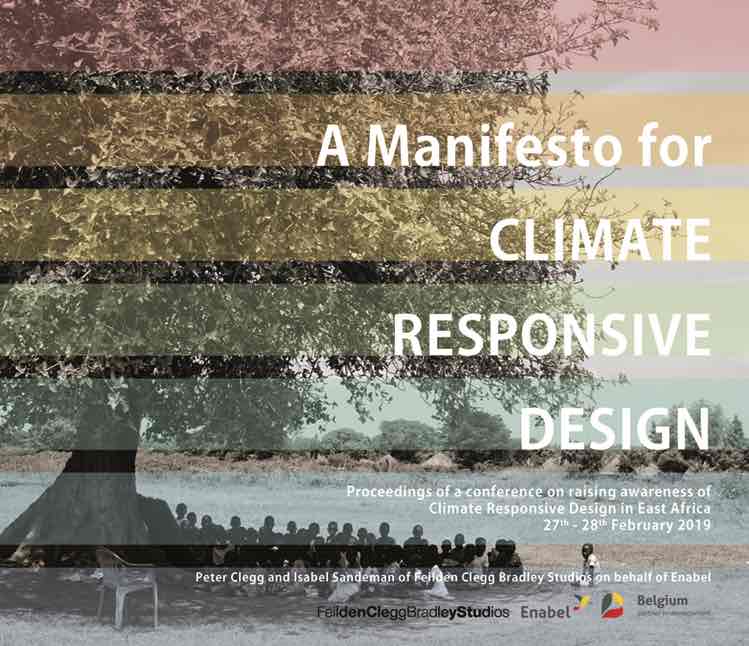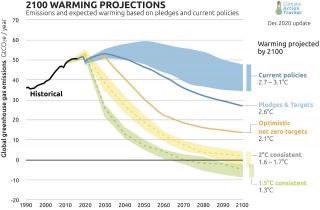
www.buildingsandcities.org/insights/commentaries/leadership-education-sustainability.html
Leadership is Critical in Mainstreaming Sustainability in Professional Education

An inspiring transformation of architectural education in the Global South shows a successful integration of sustainability.
Mark Olweny (University of Lincoln) comments on the B&C special issue EDUCATION & TRAINING: MAINSTREAMING ZERO CARBON. Leadership in Global South demonstrates the positive transformation of architectural education. The Uganda Martyrs University implemented a new curriculum to integrate sustainability into the architectural curricula. Change occurred due to staff dedication, commitment and stamina - although overcoming resistance at several levels was not easy.Introduction
The need to address climate change in architectural education has never been greater. However, transformation of courses to address it has been slow, and a possible hindrance to achieving the goals of the 2015 Paris Agreement. With Whitaker (2006) famously declaring "[a]rchitects are a lagging indicator for sustainable design", it is not difficult to see how big a role architectural education plays in any shift in the profession. Indeed, as is noted by (Shulman, 2005, p. 52), "if you wish to understand why professions develop as they do, study their nurseries, in this case, their forms of professional preparation."
For the most part, the professional preparation of architects is undertaken in a university setting, where it is subject to an array of rules and regulations, a means of ensuring confidence and quality in the educational processes leading to licensure. These codified boundaries have been criticised as promoting and reinforcing a status quo approach, producing graduates largely fit for existing practice (Milliner, 2000). This presents as a paradox in a transition to a zero-carbon future. While the consequences of doing nothing are known, any necessary changes create a daunting level of unknown-ness, with a consequential retreat into comfort zones thereby frustrating change (Randall, 2009). This is not helped by the reality that professional bodies, as key organisational stakeholders, are yet to provide clear direction of how professionals (or schools of architecture) could address climate change (Afroz, 2020). The lack of direction has ensured the persistence of status quo approaches, placing the impetus for change squarely on academic institutions, or specifically on the shoulders of individual academics willing to take on this risk. Nowhere is this more important than in the Global South, where the value of this leadership is critical in instigating and steering any transformation.
In the Buildings & Cities special issue "Education and Training: Mainstreaming Zero Carbon", Stevenson and Kwok (2020) lament the lack of representation of papers from the Global South. However, this should not be viewed as a lack of activities, with scholars having to prioritise engagements, a consequence of challenges that cannot be addressed here. The example of the Faculty of the Built Environment at Uganda Martyrs University (UMU) shows how leadership can transform an architectural programme to address sustainability and climate change. This transformation was largely derived from personal convictions that architectural education must go beyond its current professional mandate, to engage with broader responsibilities to society and the environment. In the context of East Africa, this challenge was two-fold. First, building awareness of the need to incorporate sustainability into architectural education, where it had not been considered. Second, building capacity to ensure staff and students could participate as part of a community of practice (Morton, 2012; Simpson, Janda, & Owen, 2020). UMU was in a fortunate position as pedagogical approaches in its school of architecture (founded in 2000) had not yet become entrenched.
Transforming architectural education
The transformation of UMU's architecture programme started in 2006 with an attempt to centre sustainability within the programme. This saw the development of a new programme sequence incorporating a Bachelor of Environmental Design (B.Envi.Des.) and Master of Architecture (M.Arch.)(Olweny, 2018). The goal was to integrate sustainability into all levels of the architecture curriculum. The undergraduate programme was redesigned to ensure students were adequately equipped with knowledge and skills to contribute to championing sustainability (even without completing the architecture professional degree). The Master of Architecture course was redesigned to ensure this next generation of architects would emerge as leaders in the field of sustainability and environmental design, premised on the notion that architectural education should induce "qualitative change" (Orr & Gao, 2011).
The challenges of the transformation process were immense: at the time, only two members of staff had experience in sustainability or environmental design, while none had any formal qualifications in higher education pedagogy. Most of the existing teaching approaches and content had been derived from the instructors' own educational experiences. In many cases this presented education as the mere transmission of preconceived and pre-digested knowledge. Therefore, it was necessary to address the capabilities of educators, reflecting on pedagogical approaches, sources of knowledge content, and assessment strategies among other things.
Changes to the programme were radical, involving significant pedagogical reforms. There was a shift from individual subject silos to an integrated model of teaching and learning, an approach also presented by Passe (2020). A new emphasis was also placed on the importance and value of teamwork and collaboration as a means to deliver sustainable projects. This brought together studio and theory components which previously had not connected various knowledge domains with architectural design.
Several hurdles existed in seeking to break from the status quo. Some students regarded the integrated program with suspicion as it had fewer lectures. Instead, students had to demonstrate learning in tutorials. Despite the provision of workshops to help staff with the transition, some were unwilling to adopt the new teaching approaches. Finally, although the programme exceeded existing validation requirements, the professional body presented numerous hurdles to the licensure of UMU's graduating students.
To date, UMU's programme is still the only split programme in Uganda. Its value is demonstrated by a growing demand for mid-level professionals who are conversant with sustainable design principles. Close to two decades since the changes were rolled out, there is a noticeable increase in interest in sustainable architecture, from client organisations, practice, and prospective students. This suggests two things. First, out of necessity, transformation cannot be easily delivered as a top-down approach given the long lead in times for legislative and regulatory change. Second, changes to regulations can only be driven by knowledgeable individuals able to initiate changes to rules and regulations. This requires the nurturing of expertise within schools of architecture, which in turn helps educate individuals who can then champion change at national and regional level, which reflects what Simpson et al. (2020) describe as a "middle-out perspective".

Conclusion
The changes implemented at UMU were only possible due to staff dedication and stamina to endure intense criticism for daring to think differently. The transformation of the programme was made possible by a steadfast commitment to change. There is no doubt seeking to implement such changes in an established school would be much more difficult, a consequence of entrenched attitudes and approaches. Another threat is a lack of continuity after a new approach is implemented. This can only be addressed by adequate succession planning - often not a priority for university administrations, a wicked problem affecting universities across the globe (Marco, 2020). While UMU did buffer itself against this in the short term, internal and external threats remain, which could adversely affect continued development and engagement with sustainable architecture.
Although there is still hope that there will be some directives from professional bodies to mandate higher educational standards and additional competences for entry to the profession, this is unlikely in the short term. Therefore, in the short term, change will be driven by individuals embracing an ethical agenda for an educational curriculum. This will ensure students are able to address both present and future challenges. Rules, regulations and policies will (eventually) change, but not without a critical mass of knowledgeable individuals who can effect and implement it.
References
Afroz, R. (2020). Developing a low-carbon architecture pedagogy in Bangladesh. Buildings and Cities, 1(1), 637-649. doi: 10.5334/bc.54
Clegg, P., & Sandeman, I. (Eds.). (2019). A Manifesto for Climate Responsive Design. Kampala: Enabel.
Marco, E. (2020, December 3). Commentary: A wicked higher education problem: Climate emergency requires brave leadership. Buildings and Cities. Retrieved from https://www.buildingsandcities.org/insights/commentaries/higher-education-climate.html
Milliner, L. (2000). Delight in transgression. In D. Nicol & S. Pilling (Eds.), Changing Architectural Education: Towards A New Professionalism (pp. 192-199). London: Spon Press.
Morton, J. (2012). Communities of practice in higher education: A challenge from the discipline of architecture. Linguistics and Education, 23(1), 100-111. doi:10.1016/j.linged.2011.04.002
Olweny, M. (2018). Introducing sustainability into an architectural curriculum in East Africa. International Journal of Sustainability in Higher Education, 19(6), 1131-1152. E-02-2018-0039
Orr, K., & Gao, Y. (2011). Becoming an architect: The role of work-based learning in architect training. Paper presented at the 7th International Conference on Researching Work and Learning, Shanghai, China.
Passe, U. (2020). A design workflow for integrating performance into architectural education. Buildings and Cities, 1(1), 565-578. doi: 10.5334/bc.48
Randall, R. (2009). Loss and climate change: The cost of parallel narratives. Ecopsychology, 1(3), 118-129. doi: 10.1089/eco.2009.0034
Shulman, L. S. (2005). Signature pedagogies in the professions. Daedalus, 134(3), 52-59. doi: 10.1162/0011526054622015
Simpson, K., Janda, K. B., & Owen, A. (2020). Preparing 'middle actors' to deliver zero-carbon building transitions. Buildings and Cities, 1(1), 610-624. doi: 10.5334/bc.53
Stevenson, F., & Kwok, A. (2020). Mainstreaming zero carbon: lessons for built-environment education and training. Buildings and Cities, 1(1), 687-696. doi: 10.5334/bc.84
UN-Habitat. (2016). Machakos Declaration for Sustainability in Architectural Education [Press release]
Whitaker, B. (2006, May 06). Architects are lagging indicators for sustainable design. The New York Times Online Edition. Retrieved from http://www.nytimes.com/2006/05/17/business/businessspecial2/17build.html?pagewanted=1&_r=2#
Latest Peer-Reviewed Journal Content
Youth engagement in urban living labs: tools, methods and pedagogies
N Charalambous, C Panayi, C Mady, T Augustinčić & D Berc
Co-creating urban transformation: a stakeholder analysis for Germany’s heat transition
P Heger, C Bieber, M Hendawy & A Shooshtari
Placemaking living lab: creating resilient social and spatial infrastructures
M Dodd, N Madabhushi & R Lees
Church pipe organs: historical tuning records as indoor environmental evidence
B Bingley, A Knight & Y Xing
A framework for 1.5°C-aligned GHG budgets in architecture
G Betti, I Spaar, D Bachmann, A Jerosch-Herold, E Kühner, R Yang, K Avhad & S Sinning
Net zero retrofit of the building stock [editorial]
D Godoy-Shimizu & P Steadman
Co-learning in living labs: nurturing civic agency and resilience
A Belfield
The importance of multi-roles and code-switching in living labs
H Noller & A Tarik
Researchers’ shifting roles in living labs for knowledge co-production
C-C Dobre & G Faldi
Increasing civic resilience in urban living labs: city authorities’ roles
E Alatalo, M Laine & M Kyrönviita
Co-curation as civic practice in community engagement
Z Li, M Sunikka-Blank, R Purohit & F Samuel
Preserving buildings: emission reductions from circular economy strategies in Austria
N Alaux, V Kulmer, J Vogel & A Passer
Urban living labs: relationality between institutions and local circularity
P Palo, M Adelfio, J Lundin & E Brandão
Living labs: epistemic modelling, temporariness and land value
J Clossick, T Khonsari & U Steven
Co-creating interventions to prevent mosquito-borne disease transmission in hospitals
O Sloan Wood, E Lupenza, D M Agnello, J B Knudsen, M Msellem, K L Schiøler & F Saleh
Circularity at the neighbourhood scale: co-creative living lab lessons
J Honsa, A Versele, T Van de Kerckhove & C Piccardo
Positive energy districts and energy communities: how living labs create value
E Malakhatka, O Shafqat, A Sandoff & L Thuvander
Built environment governance and professionalism: the end of laissez-faire (again)
S Foxell
Co-creating justice in housing energy transitions through energy living labs
D Ricci, C Leiwakabessy, S van Wieringen, P de Koning & T Konstantinou
HVAC characterisation of existing Canadian buildings for decarbonisation retrofit identification
J Adebisi & J J McArthur
Simulation and the building performance gap [editorial]
M Donn
Developing criteria for effective building-sector commitments in nationally determined contributions
P Graham, K McFarlane & M Taheri
Join Our Community

The most important part of any journal is our people – readers, authors, reviewers, editorial board members and editors. You are cordially invited to join our community by joining our mailing list. We send out occasional emails about the journal – calls for papers, special issues, events and more.
We will not share your email with third parties. Read more



Latest Commentaries
COP30 Report
Matti Kuittinen (Aalto University) reflects on his experience of attending the 2025 UN Conference of the Parties in Belém, Brazil. The roadmaps and commitments failed to deliver the objectives of the 2025 Paris Agreement. However, 2 countries - Japan and Senegal - announced they are creating roadmaps to decarbonise their buildings. An international group of government ministers put housing on the agenda - specifying the need for reduced carbon and energy use along with affordability, quality and climate resilience.
Building-Related Research: New Context, New Challenges
Raymond J. Cole (University of British Columbia) reflects on the key challenges raised in the 34 commissioned essays for Buildings & Cities 5th anniversary. Not only are key research issues identified, but the consequences of changing contexts for conducting research and tailoring its influence on society are highlighted as key areas of action.